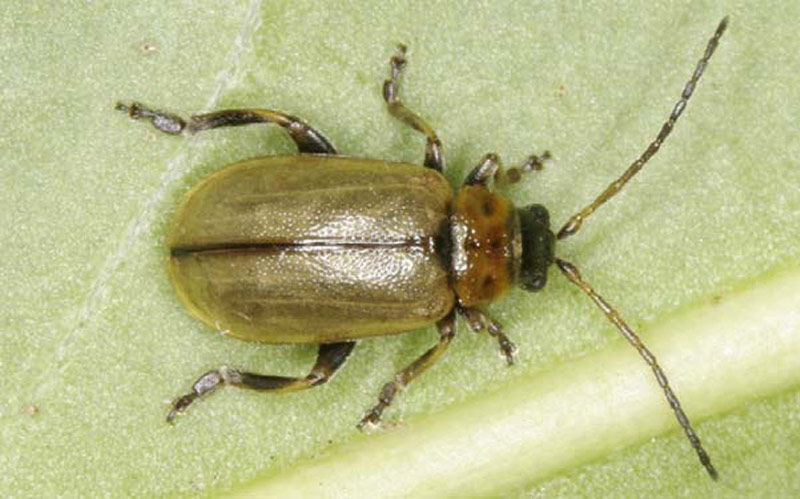FAQs: Heather Beetle - Everything You Need to Know About This Moorland Threat
- Rob Beeson

- Nov 5
- 4 min read
Updated: Nov 6

Jump to Section
What is a heather beetle?
The heather beetle (Lochmaea suturalis) is a tiny olive-brown insect, only about 6mm long - roughly the size of a grain of rice. Despite being native to the UK and part of moorland ecosystems for thousands of years, this beetle has recently been causing serious damage to our iconic purple heather landscapes. The beetle is extremely well-camouflaged and blends perfectly with heather and moss, making it difficult to spot even during major outbreaks.
Why are heather beetles a problem now?
While heather beetles have always lived on UK moorlands, their population outbreaks have become more frequent and severe in recent years. These outbreaks cause widespread die-off of heather across large areas, threatening the future of these precious habitats. Climate change is believed to be making conditions more favourable for beetle populations to explode.
When do heather beetles cause the most damage?
The most destructive period occurs in early to mid-summer (July to August). Here's what happens throughout the year:
Spring: Adult beetles wake from winter hibernation and begin feeding.
Late April onwards: Females lay up to 700-1,000 eggs in damp moss.
Early July: Eggs hatch into larvae, this is when the real damage begins.
July-August: Countless hungry larvae strip heather of its leaves.
Late August-September: New adult beetles emerge before hibernating for winter.
How can I tell if heather has been damaged by beetles?
Look for these warning signs:
Stripped plants: Heather with bare red or grey stalks and missing leaves.
Fox-red colouring: Damaged heather turns a distinctive orangey-brown colour in early autumn.
Even damage patterns: Unlike frost damage, beetle damage affects both sheltered and exposed areas equally.
Dead patches: Large areas where heather has died completely, often replaced by coarse grasses.
You'll usually see the damage before you spot any beetles themselves.
Why does heather matter so much?
Heather is a keystone species, it's the foundation of the entire moorland ecosystem. When heather disappears, the consequences spread throughout the landscape:
Wildlife suffers: Birds like red grouse and golden plover depend on heather for food and shelter. The Emperor moth caterpillar also feeds exclusively on heather.
The landscape changes: Dead heather is replaced by less valuable coarse grasses like molinia, fundamentally altering the moorland ecosystem.
Fire risk increases dramatically: Stands of dead heather combined with dry grasses create extremely fire-prone landscapes. Healthy, damp moorland naturally resists fire, but beetle-damaged areas become tinderboxes waiting for a spark.
Economic impacts: Moorland estates that depend on healthy grouse populations face financial losses.
How are land managers dealing with heather beetle outbreaks?
This is a complicated and sometimes controversial issue. Several approaches are used:
Controlled burning: Burning damaged areas can help heather regenerate more quickly and remove dangerous fire fuel. However, this method is debated, with some studies showing mixed long-term results.
Cutting: Removing the dead heather canopy to allow regeneration from remaining stems.
Drainage: Managing water levels to reduce humidity that beetle eggs need to survive.
Grazing: Using sheep to create more open heather structure.
The challenge is that there's often a gap between what land managers observe working on the ground and what scientific studies can definitively prove.
What's the controversy about burning beetle-damaged heather?
Many experienced moorland keepers report success with carefully controlled burns of beetle-damaged heather. They observe faster regeneration and reduced fire risk. However, Natural England's official position is that there isn't enough "robust experimental evidence" to prove burning reliably helps.
This has led to a precautionary approach where burning licenses are often denied. Critics argue this ignores the serious "risk of doing nothing" - permanent habitat loss and catastrophic wildfire danger.
What is Adaptive Licensing?
Adaptive Licensing is a proposed solution that would:
Allow small-scale, controlled burns in high-risk beetle-damaged areas.
Require careful monitoring and reporting of every burn.
Treat each management action as an opportunity to learn and build evidence.
Enable urgent action to save habitats while simultaneously creating the scientific evidence base.
This approach recognizes that waiting decades for definitive research could mean losing irreplaceable moorland habitats in the meantime.
Why is expert knowledge from moorland keepers important?
Moorland keepers possess deep, place-based knowledge gained from years of working on specific landscapes. They can predict how fire will behave under particular conditions, understand site-specific factors like soil depth and moisture, and time interventions precisely.
This expertise is difficult to replicate in controlled scientific experiments but is crucial for successful conservation. For example, carefully burned beetle-damaged areas can become perfect habitat for rare birds like the red-listed golden plover.
What can be done to protect our moorlands?
Protecting UK moorlands from heather beetle damage requires:
Bridging policy and practice: Valuing both scientific evidence and expert land manager knowledge.
Adaptive management: Being willing to act, monitor results, and learn from real-world interventions.
Collaboration: Working together across conservation organizations, researchers, and land managers.
Urgent action: Recognizing that the risks of inaction - permanent habitat loss and wildfire - are too severe to ignore.
Our iconic purple moorlands have survived for thousands of years, but they need active, informed stewardship to thrive in the face of modern challenges like climate change and increasingly severe beetle outbreaks.

